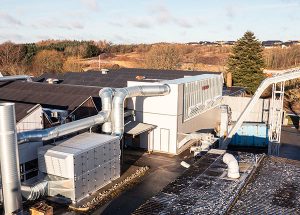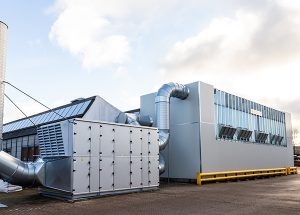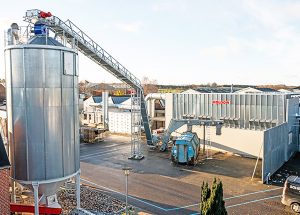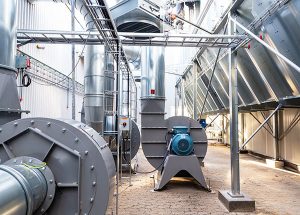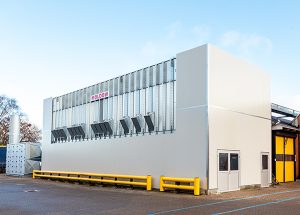NEW EFFICIENT DUST EXTRACTION SYSTEMS FOR VELUX
Due to increased production needs and a desire for more energy-efficient solutions, VELUX decided to invest in new dust extraction and replace two old filters with new ones.
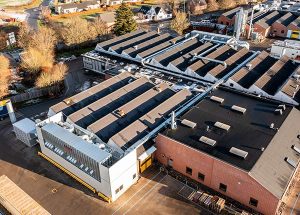
In the production halls in Østbirk, Denmark, between the two new dust extraction systems, the well-known wooden VELUX roof windows are produced. This results in large amounts of material-filled air, which must be extracted to guarantee a safe and healthy working environment.
As a specialist in just that, we were chosen to supply the new systems. They include two filters, 13 fans, two heat exchangers, energy optimization, approx. 118 m chain conveyor, piping, electrical work, spark extinguishing equipment, engineering work, project management, assembly and commissioning.
– We have collaborated with Moldow for many years – and the many years of collaboration have shown that they can deliver efficient, reliable solutions for extraction and air filtration. The old systems were outdated and did not meet our standards for energy-optimized equipment. We require systems that ensure a good working environment for our employees while at the same time being as energy efficient as possible, Charlotte Bjørn Schougaard, QHSE & Energy Manager at the VELUX factory in Østbirk explains.
Large Savings to Achieve
Energy optimization is high on the agenda at VELUX, so ensuring as low energy consumption as possible has been a focus area throughout the project.
– Dust extraction systems consume a lot of energy, so large savings can be achieved by choosing the right, energy-optimized solution. This is something that is crucial for our extraction solutions – of course based on the customer’s wishes and facilities, explains Product Manager at Moldow, Johannes Ipsen.
Both the filters, fans and chain conveyors are, thanks to their design, very efficient in operation. This in itself brings benefits in terms of energy consumption. In addition, high efficiency is achieved by reusing the extracted air and the heat.
– As much of the extracted air as possible is reused as replacement air for enclosed machines in the production halls. The heat from the remaining air volume is reused via heat exchangers to heat the replacement air for the buildings, which ensures optimal air balance. Each extraction system includes a cross-flow heat exchanger designed for 35,000 m3 per hour, says Johannes Ipsen from Moldow.
In addition, VELUX has also chosen to invest in a special control system to ensure as low energy consumption as possible:
– We have also supplied an energy manager system for each system, which ensures that only the most necessary amount of energy is used. The system monitors machines via sensors and dampers and adapts the extraction and thus the energy consumption to the actual need at all times, says Johannes Ipsen from Moldow.
Dust Extraction System Design – the art of making ends meet
– For this project, the key was finding a solution that could meet the need for extraction of a large, continuous amount of waste material and some dust-filled air as well as the requirements for high energy efficiency and explosion safety while taking into account the available space and the factory’s neighbors, says Johannes Ipsen from Moldow.
One of the extraction systems is designed for 90,000 m3/h and includes six fans, while the other is for 85,000 m3/h with seven fans.
– Based on the available space and the wish for highly efficient operation and safety levels, two MHL chain filters were chosen. The MHL filter can handle the large amounts of waste material-filled air – thanks to the design and continuous and very effective cleaning of the filter bags – and it is also Ex-certified and therefore very safe, explains Johannes Ipsen from Moldow.
The large VELUX factory in Østbirk, Denmark, is located in the middle of the city. So out of consideration for the surroundings, a wall has been built around each filter to reduce the noise levels. In addition, a type of fan that is less noisy fans than the old ones has been chosen.
Explosion-Proof Dust Extraction Systems for ATEX
A crucial subject when talking about extraction of dust-filled air is ATEX.
– When extracting and filtering dust-filled air, there is a risk of a potentially explosive atmosphere (ATEX) and thus dust explosions. Therefore, companies are required to draw up a classification plan (extended APV) in accordance with EU legislation. Its zone designations are used to select the correct components and make demands on the suppliers, explains QA Manager at Moldow, Carsten Hembo.
– Based on VELUX’ classification plan, we have designed two dust extraction systems with components that meet the requirements for the specified zones and the stated amount of dust.
– The included components; filters, fans, rotary valves and chain conveyors, are designed according to the ATEX standards’ requirements for no own ignition sources. Due to the risk of external ignition sources, the filter is equipped with explosion relief. So in the event of an explosion, the pressure will be relieved safely, and the filter and surroundings are protected.
– As an additional provision, VELUX has chosen to include a spark detection and extinguishing system, which reduces the risk of explosions to the most improbable, explains QA Manager at Moldow, Carsten Hembo.
| Customer | VELUX A/S |
| Location | Østbirk, Denmark |
| Waste type | Chips and dust |
| Product | 2 x MHL – ATEX |
| Air Quantity | 90,000 + 85,000 m3/h |
| Heat Exchanger | 2 x 35,000 m3/h |
